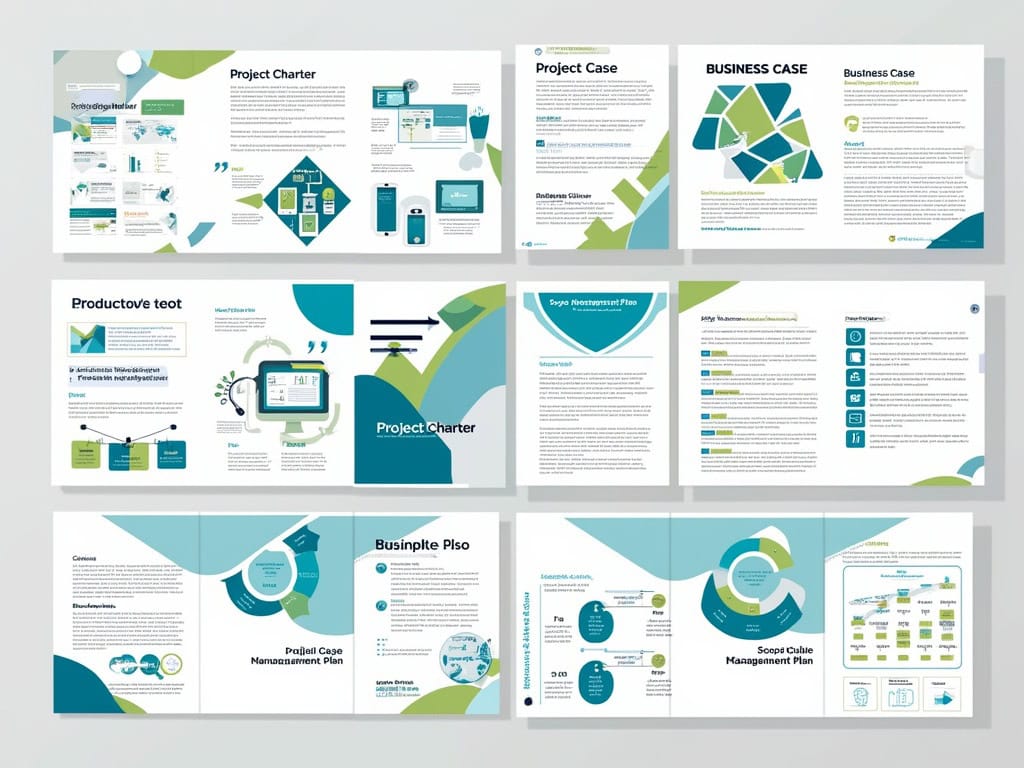
Project Management Manual Templates
Project management manual templates provide a strategic roadmap for organizations to standardize and streamline their project execution processes. These comprehensive templates serve as critical tools that guide teams from project initiation to closure, offering a structured approach to managing complex initiatives while maintaining flexibility for project-specific requirements.
Key Takeaways
- A well-designed project management manual template includes essential components like Project Charter, Business Case, and Scope Management Plan.
- Templates help prevent scope creep and ensure consistent project delivery across the organization.
- Customizable templates can be tailored to specific industry needs and workflows.
- Digital integration with project management software enhances template effectiveness and collaboration.
- Systematic implementation and continuous refinement are crucial for template success.
Effective project management requires clear documentation and consistent processes. Project management templates create standardization that saves time and reduces errors across your organization. These frameworks establish repeatable methods that teams can follow for each new initiative.
Your manual template should contain sections covering all project phases – from initial concept to final delivery. This comprehensive approach ensures nothing falls through the cracks during execution. Each component connects to form a cohesive system that supports project success.
Templates adapt to various project types while maintaining core principles. You’ll find they balance structure with adaptability, giving project managers the foundation needed for proper oversight. The right template makes complex management tasks more approachable.
Digital project management platforms enhance template functionality. When integrated with project tracking software, your templates become interactive tools that support real-time collaboration. This integration creates seamless workflows between planning documents and execution.
Implementing templates requires thoughtful planning. Start by identifying your organization’s specific needs before selecting or developing appropriate templates. Consider your industry requirements, team structure, and typical project complexity during this process.
Regular updates keep templates relevant. Project methodologies evolve, requiring periodic assessment of your manual’s effectiveness. Collect feedback from users and adjust components that don’t meet current needs or best practices in project management standards.
“Project management manual templates act as a strategic compass, providing teams with a structured yet flexible framework to guide projects from initiation to successful closure. By standardizing processes and integrating digital tools, they empower organizations to streamline execution while adapting to the unique demands of each initiative.”
Essential Components of Project Management Templates
Your project management manual template needs to include several core components to effectively guide projects from initiation to closure. A comprehensive template serves as your strategic roadmap, helping standardize processes across your organization while providing flexibility for project-specific needs.
The foundation of any effective project management manual template begins with the Project Charter. This document formally authorizes the project and provides you with the authority to apply organizational resources. It includes the business need, high-level requirements, and project success criteria that establish clear targets from the start.
Your Business Case template justifies resource investment by documenting the expected benefits against costs. This component helps you secure stakeholder buy-in by demonstrating the project’s value alignment with organizational objectives.
A well-structured Scope Management Plan helps prevent scope creep – one of the most common causes of project failure. This template section outlines how scope will be defined, validated, and controlled throughout the project lifecycle.
The following templates are essential for your project management manual:
- Work Breakdown Structure (WBS) – Decomposes deliverables into manageable work packages
- Risk Management Plan – Identifies potential issues and response strategies
- Communication Management Plan – Determines who needs what information and when
- Resource Management Plan – Outlines how human and material resources will be acquired
- Schedule Management Plan – Details how the project timeline will be developed and controlled
- Quality Management Plan – Establishes standards and processes to ensure deliverables meet requirements
Your project management manual template should align with industry standards like the Project Management Body of Knowledge (PMBOK®), providing a framework consistent with professional best practices.
This table summarizes the key template components and their strategic purpose:
| Template Component | Strategic Purpose |
|---|---|
| Project Charter | Authorizes project and aligns stakeholders |
| Business Case | Justifies investment and defines value |
| Scope Management Plan | Prevents uncontrolled changes |
| Work Breakdown Structure | Organizes deliverables logically |
| Risk Management Plan | Mitigates threats to success |
| Communication Plan | Ensures information flow to stakeholders |
With these essential components in your project management manual template, you’ll create a structured approach that supports project execution while maintaining the flexibility to adapt to changing conditions. Effective templates don’t just document processes—they transform how your teams collaborate, make decisions, and deliver consistent results.
Organizations that fail to standardize project management processes often experience a 20% decrease in project success rate compared to those that do.
hbr.org
Strategic Benefits and Impact
Implementing effective project management manual templates delivers substantial strategic advantages to your organization. These structured documents don’t just organize tasks – they transform how you execute projects while providing clear guidance throughout each phase of the project lifecycle.
A comprehensive project management manual template creates consistency across your project portfolio. You’ll notice immediate improvements in workflow standardization, allowing team members to follow established protocols rather than reinventing processes for each initiative. This standardization is especially valuable when managing parallel project implementations that might otherwise create resource conflicts.
Your project manual templates enable better decision-making by providing:
- Clear accountability frameworks with defined roles
- Standardized risk assessment procedures
- Consistent documentation practices
- Established quality control mechanisms
- Streamlined status reporting processes
The impact on project success metrics is significant. Organizations using project management manual templates experience up to 70% reduction in project failure rates. Additionally, you’ll likely reduce wasted investment, as nearly 10% of project dollars are typically lost without proper documentation and planning systems.
Measurable Efficiency Gains
Your team will benefit from several measurable efficiency improvements when utilizing project management manual templates:
- Reduced onboarding time for new project team members
- Faster project initiation phases
- More accurate resource allocation
- Decreased documentation errors
- Enhanced stakeholder alignment
These efficiency gains translate directly to cost savings. By implementing comprehensive project management manual templates, you can expect to reduce administrative overhead by 25-30% while improving project collaboration across departments.
Statistical evidence confirms these benefits: 77% of high-performing projects utilize standardized project management manual templates and supporting software. The structured approach provides you with critical advantages in today’s complex project environments.
When building your project management manual template library, you’ll want to include templates for:
- Project charter development
- Scope definition documents
- Resource allocation matrices
- Risk assessment protocols
- Quality management procedures
- Communication management plans
- Change control processes
Each template strengthens your project governance capabilities. The consistency provided by a well-designed project management manual template system ensures you maintain document version control and create institutional knowledge that persists beyond individual project completions.
Organizations that standardize their project management practices have project success rates that are 22% higher than those that do not.
hbr.org
Industry-Specific Template Applications
Effective project management manual templates must be tailored to your industry’s unique requirements. A one-size-fits-all approach won’t deliver the strategic advantage you need for project success. Your project management manual template should reflect specific workflows, compliance needs, and delivery methodologies particular to your sector.
IT and software development teams benefit from specialized project management manual templates that accommodate agile methodologies. These templates typically include user story mapping, sprint planning documents, and technical debt logs. For DevOps teams, templates that integrate agile principles with continuous integration/continuous deployment (CI/CD) pipelines prove particularly valuable.
Marketing departments require templates focused on campaign timelines, creative briefs, and approval workflows. Your marketing project management manual template should incorporate content calendars, brand guideline checklists, and performance tracking metrics. These specialized templates help prevent the common scope creep that plagues marketing initiatives.
Construction and Manufacturing Applications
Construction and manufacturing sectors need robust project management manual templates that emphasize safety protocols, regulatory compliance, and supply chain management. These industries benefit from templates featuring:
- Detailed material procurement schedules
- Quality control inspection checklists
- Equipment allocation matrices
- Site safety assessment forms
- Regulatory compliance documentation
The construction industry particularly benefits from templates that support project constraints and dependencies mapping. Construction project management manual templates must account for weather contingencies, permit approval processes, and subcontractor coordination.
Healthcare organizations require templates addressing patient confidentiality, regulatory compliance, and risk mitigation. Your healthcare project management manual template should include HIPAA compliance checklists, clinical trial documentation frameworks, and patient safety protocols.
Financial services benefit from templates emphasizing data security, audit trails, and regulatory reporting. These sectors need project management manual templates that incorporate detailed risk appetite and tolerance assessments.
Education institutions find value in templates structured around academic calendars, curriculum development, and student outcome tracking. Educational project management manual templates typically include stakeholder communication plans for faculty, administration, and parents.
Non-profit organizations benefit from templates focusing on grant milestones, volunteer coordination, and donor reporting. These specialized templates help maximize limited resources while maintaining accountability to stakeholders.
Regardless of industry, your project management manual template should be customizable while maintaining core elements that ensure consistency and compliance with organizational standards. By implementing industry-specific templates, you’ll accelerate project initiation, improve team alignment, and increase the likelihood of delivering successful outcomes.
Companies that adopt project management practices are 28 times more likely to complete projects on time and within budget compared to those that do not.
forbes.com
Technology and Template Integration
Your project management manual template will become even more powerful when integrated with the right technology tools. Top project management software platforms offer built-in template functionalities that transform static documentation into dynamic collaboration hubs.
Wrike delivers exceptional template versatility with its customizable workflows and approval processes. You’ll find this particularly useful when your project management manual template needs to adapt to changing project requirements. The platform’s real-time updates ensure your project management manual template stays current across all team members.
Atlassian Jira excels with its extensive template marketplace, where you can find specialized project management manual templates for various methodologies. When working on complex collaborative projects, Jira’s integration capabilities allow your templates to connect with other business systems.
Monday.com offers visually appealing project management manual template options that enhance user adoption. Their drag-and-drop interface makes customizing your templates straightforward even for team members with limited technical expertise. This accessibility encourages consistent template usage throughout your organization.
Microsoft Project provides enterprise-grade project management manual template solutions with robust reporting features. Your template data can be easily exported to other Microsoft tools, creating a seamless documentation ecosystem. This integration proves especially valuable when managing integrated project components across departments.
Key Benefits of Digital Template Integration
Digital project management manual template platforms offer significant advantages over traditional document-based approaches:
- Real-time collaboration allows multiple team members to work within the same project management manual template simultaneously.
- Automated notifications alert stakeholders when template sections require attention.
- Version control prevents confusion by maintaining a single source of truth.
- Analytics dashboards track template usage and compliance metrics.
- Mobile access ensures your project management manual template remains accessible anywhere.
The true power of technology integration comes from how it transforms your project management manual template from a static document into a living system. When properly implemented, your digital templates will capture institutional knowledge, streamline onboarding, and establish consistent project management manual template practices across your organization.
Expert Insight: **Professional Tip:** Enhance your project management manual template by integrating it with leading technology tools to transform static documents into dynamic collaboration platforms. Utilize software like Wrike for customizable workflows, Atlassian Jira for a diverse template marketplace, or Monday.com for user-friendly designs that encourage adoption. By leveraging real-time collaboration, automated notifications, and robust analytics, your templates will not only adapt to changing requirements but also foster consistency and efficiency across your organization.
Implementing and Optimizing Templates
Creating effective project management manual templates is only half the battle. You’ll need a strategic approach to implement and optimize these templates throughout your organization. A well-executed template strategy can transform your project management capabilities and drive consistent results.
When customizing your project management manual template, focus on balancing standardization with flexibility. Adjust templates to reflect your organization’s specific workflows while maintaining core project management principles. Remove irrelevant sections and add industry-specific components that address your unique challenges.
Training is essential for successful template adoption. Your team members need comprehensive guidance on:
- Understanding the purpose behind each template section
- Properly completing documentation fields
- Identifying when to use specific templates
- Accessing and sharing template information efficiently
- Maintaining version control throughout projects
Continuous refinement keeps your project management manual templates relevant. Schedule quarterly reviews to evaluate template effectiveness and incorporate lessons learned. This iterative improvement process ensures your templates evolve alongside your organizational capabilities.
Template Implementation Strategy
Your implementation approach should align with your organization’s project management maturity level. Consider these implementation phases:
- Assessment: Evaluate current documentation practices and identify gaps
- Design: Create or modify templates to address specific needs
- Pilot: Test templates on smaller projects before organization-wide rollout
- Full deployment: Systematically introduce templates across all projects
- Monitoring: Track template usage and effectiveness metrics
The long-term benefits of systematic project implementation approaches include enhanced governance, reduced onboarding time, and improved project success rates. Your templates create organizational memory, preserving valuable knowledge even as team members change.
For maximum effectiveness, integrate your project management manual template with digital tools. This connection enables automated workflows, real-time collaboration, and enhanced visibility. Templates should facilitate project collaboration rather than creating administrative burdens.
Remember that template optimization isn’t a one-time event. Your templates should adapt to changing methodologies and business requirements. Regular feedback sessions with project managers help identify improvement opportunities and ensure templates remain valuable assets rather than documentation hurdles.
By taking a strategic approach to template implementation, you’ll establish consistent project management practices that improve outcomes across your entire organization’s portfolio of initiatives.






